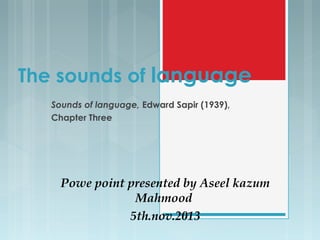
The sounds of language
- 1. The sounds of language Sounds of language, Edward Sapir (1939), Chapter Three Powe point presented by Aseel kazum Mahmood 5th.nov.2013
- 2. The Sounds of Language The two terms ‘language’ and ‘sound’ are so common in introductory textbooks about language and linguistics and wherever there is a need to talk about communication. Sounds are essential to speech. We use speech for communication and sounds of speech are the fundamental elements of such a communication system. We consider sounds to be the basic components of speech, The ability to produce sounds is not sufficient for communication.
- 3. The production of sound We can define the formulation of speech sound in terms of three stages:
- 4. Accent and Sounds We can summarize all issues related by answering the question below:
- 5. Accent Roch definition(2009). Sapir definition(1933). Language can take various forms:
- 6. Accent how this definition relates to language and sound in far than the different pronunciation of the same language itself, more likely, of that of speakers of other languages? What makes the speaker sense a mysterious accent in the way foreign speakers produce their native language?
- 7. Variability of speech The main goal of the phonological research community is to understand the variation in the sound structure of language. A focus of this feature that sets it apart from other variation is the emphasis on understanding how knowledge of variation might be presented cognitively, a growing consensus among researchers is that at least some aspects of acoustic and articulatory variations are represented cognitively, rather than being derived by universal principles (munson2009).
- 9. The possibilty of aquiring new sounds Of course the power to produce these inhibited adjustments is not entirely lost, but the extreme difficulty we experience in learning the new sounds of foreign languages is sufficient evidence of the strange rigidity that has set in for most people in the voluntary control of the speech organs.
- 10. Organs of speech
- 11. Organs of speech A detailed account of the organs mentioned below:
- 12. Consonant a consonant is a speech sound that is articulated with complete or partial closure of the vocal tract. Examples are [p], pronounced with the lips; [t], pronounced with the front of the tongue; [k], pronounced with the back of the tongue; [h], pronounced in the throat; [f] and [s], pronounced by forcing air through a narrow channel (fricatives); and [m] and [n], which have air flowing through the nose (nasals). Contrasting with consonants are vowels.’’
- 13. Vowels Vowel: Is a speech sound produced with the air going out freely, without any obstruction in the vocal tract .There are three kinds of vowels. Simple(pure) vowels. Diphthong Triphthong Pure vowels are described according to four principles. The height of the tongue in the month The part of the tongue which is raised to pronounce the vowel. Lip rounding The length
- 14. Sound differences Speech sounds can differ from one another in three ways:
- 15. Organic Classification of speech sound we can put any sound into its proper place by the appropriate answer to four main questions: What is the position of the glottal cords during its articulation? Does the breath pass into the mouth alone or is it also allowed to stream into the nose? Does the breath pass freely through the mouth or is it impeded at some point and, if so, in what manner? What are the precise points of articulation in the mouth?
- 16. Factors influencing sound understanding and recognition understanding and recognizing the message delivered by the sound or sound sequence is influenced by other factors
- 17. Thank you
